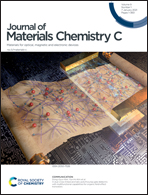Two-dimensional vanadium tetrafluoride with antiferromagnetic ferroelasticity and bidirectional negative Poisson's ratio†
Abstract
Two-dimensional (2D) antiferromagnetic ferroelasticity and bidirectional auxeticity are highly sought for next-generation nanoelectronics, spintronics, or mechanical devices, but are rarely reported. Herein, using first-principles calculations, we report the coexistence of these intriguing properties in the vanadium tetrafluoride (VF4) monolayer. 2D VF4 is a direct wide-gap semiconductor with antiferromagnetic order stemming from the synergy between the direct exchange and superexchange of the dxy orbitals in adjacent V atoms. Notably, 2D VF4 features ferroelasticity with a moderate reversible strain and low transition barrier, enabling manipulation of the in-plane magnetic easy axis via external strain. Additionally, 2D VF4 simultaneously harbors an ultra-large negative Poisson's ratio (NPR) in both the in-plane and out-of-plane directions due to the hinged connection between the neighboring VF6 octahedra. Our work highlights a new material for the exploration of 2D multiferroic physics and the integration of antiferromagnetic ferroelasticity and large bidirectional auxeticity renders 2D VF4 a versatile candidate for the development of novel multifunctional devices.



 Please wait while we load your content...
Please wait while we load your content...